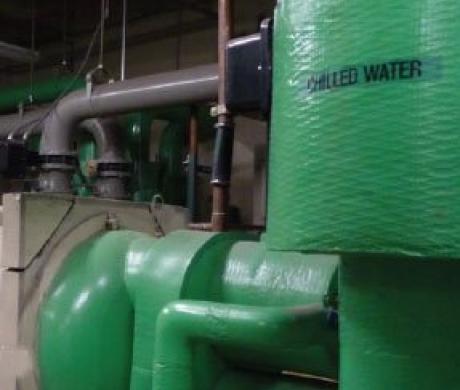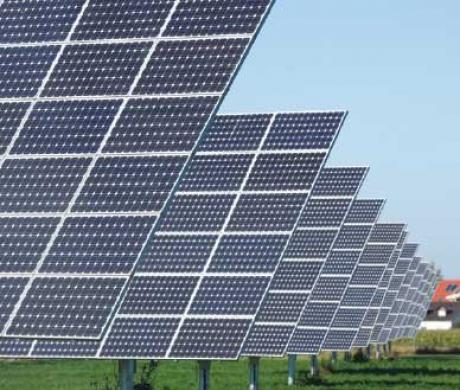10 Questions to Ask Before Installing Solar Power on Agency Facilities
Eva Spiegel is communications director for the League and can be reached at espiegel@cacities.org. Yvonne Hunter, program director of the Institute for Local Government’s Climate Change Program, also contributed to this article and can be reached at yhunter@ca-ilg.org.
As the cost of installing solar photovoltaic (PV) systems on agency facilities has declined over the past few years, local agencies are considering the benefits. Solar PV systems convert sunlight to electricity and offer opportunities to reduce energy costs, save taxpayer dollars, save energy and increase sustainability. Asking the right questions can help make the project a success. The information provided here is a starting point; local officials are encouraged to consult their legal, financial and public works staff as they move ahead.
1. Our city is considering installing a solar PV system at an agency facility. What issues should we consider when deciding whether to self-finance or work with a third party using a power purchase agreement (PPA)?
Several key issues need to be considered. Generally, if the agency has the financial resources (either using its General Fund or selling bonds) to pay for the system, that may be the preferred option, as the energy savings benefits accrue more quickly. When the agency does not have resources to self-finance, working with a third party through a PPA is another option.
A PPA is a financial arrangement in which a third party owns, operates and maintains the PV system, and a host customer, such as a local agency, agrees to place the system on its property. The host customer purchases the system’s electric output from the solar services provider for a predetermined period after which the host customer typically owns the system. Generally the payments to the private company are made possible through the energy savings from generating electricity from the PV system, as opposed to buying it from the utility that serves the agency. This allows the host customer to receive stable and usually lower-cost electricity, while the third party acquires financial benefits, such as tax credits and income generated from the sale of electricity to the host customer. The key is to consider the individual community’s unique fiscal situation and policies and explore which options are the best fit.
For Sacramento the major consideration was financial. Yvette Rincon, sustainability program manager for the City of Sacramento, says, “If a city has the money to cover the cost of solar up front, it should consider owning the system. You immediately get the savings for generating your own power. But you have to also consider the cost of maintaining the system.”
The City of Brea financed its PV systems by issuing bonds. City Manager Tim O’Donnell explains, “Our PV systems are on top of city hall, the community center and shade structures in the parking lot and the city’s 30 million-gallon water reservoir. We generate 1.8 megawatts of power. The program cost $17 million for both the energy-efficiency retrofits and the solar PV systems. Before deciding to finance the systems using bonds, we calculated how much the energy generated would cost compared to the current electricity rates and likely price increases in coming years. At the end of a 25-year program we project we’ll net $13 million.”
Lindsay Joye, marketing engineer for the City of Palo Alto Utilities, suggests that both options should be compared to see which is best. “If a public agency self-finances the system, the project won’t qualify for the 30 percent federal tax credit and accelerated depreciation,” says Joye. “A PPA allows a third-party system owner with a tax appetite to take the tax credit and accelerated depreciation.”
In deciding which option to use, seek expert help to analyze the value of each option versus business as usual. This analysis will allow the jurisdiction to determine whether a PPA will result in a cost-neutral, cost-saving or additional-cost project.
When seeking help in assessing options, it’s a good idea to use someone who does not have a financial stake in your city’s decisions or outcomes.
In general, when using a PPA, make sure that the PV system installed has a longer life than the PPA itself and factor in maintenance costs once your city owns the system.
2. When using a PPA, what consumer protection elements should we require?
Dell Tredinnick, project development manager for the City of Santa Rosa, offers this advice: “Make sure the product and performance are specified. Have your engineering and purchasing staff put in the same kind of safeguards, consumer protection and performance warranties that your city uses when buying a car or a motor. The equipment must meet certain standards. The city’s purchasing department should establish criteria for the agreement based on the city’s needs and the system.”
Consider including a monitoring and performance element, within the PPA or as a separate contract, to ensure the system delivers what is promised in terms of electricity generated and cost savings.
Specify who is responsible for system maintenance: the third party or agency employees. Consider addressing what will happen if the system’s downtime exceeds what was promised. In such a case the savings will be lower, a negative impact for which the agency may want to be compensated.
3. Should solar be installed before assessing the potential for energy-efficiency retrofits in the building?
No. Tredinnick says, “Reduce before you produce. Don’t solarize inefficiency. Get your energy needs down before you consider installing solar, which is expensive. Most energy-efficiency opportunities will have a much faster payback than buying a larger PV system.”
When examining energy-efficiency options, consult your local utility company to take advantage of any available financial incentives, which can reduce the upfront costs and help shorten the payback period.
4. What should we know about sizing the PV solar system?
Do not oversize. Calculate what your energy-efficiency operations or retrofits will save you, and then size the PV array to meet all or part of the remaining electricity needs. There is no financial gain to oversizing the system to generate more electricity than is used on-site over a 12-month period. Even if you generate more power than you use on-site, the utility will pay you only for the excess up to a maximum amount set by state law, which changes periodically.
5. How do we make sure the company installing the PV system is reputable and will deliver what is promised?
Selecting a solar PV vendor is like any other public works or infrastructure project. The same process for evaluating and selecting vendors applies.
Regardless of whether the project is done with a PPA or self-financed, make sure the bidders are companies in good standing. Use due diligence to review each company’s financials and related information.
You may want to query other municipalities that have completed similar projects to find out which companies or systems they used. Get bids, and issue a request for qualifications to be submitted with the bid. Make sure warranties are in place.
6. What should we know about retaining our options to use possible greenhouse gas emissions offsets or credits when California’s cap-and-trade system gets going?
Although California’s cap-and-trade system applies to a specific set of generators of greenhouse gas emissions, such as electricity producers and heavy industry, other producers of greenhouse gas emissions have an opportunity to participate in the system through what are called “credits” and “offsets.” Whether and how an agency can take advantage of greenhouse gas offsets from solar PV systems will depend on several factors, such as how offsets are measured, who owns the system and who finances it. Thus, local agencies may wish to include the issue of greenhouse gas credits or offsets as part of the vendor contract negotiations. Depending on your situation, you may choose to retain the renewable energy credits or sell them to a third party. This could also be part of a PPA, by asking companies to take cap-and-trade credits into account when negotiating an agreement. One city suggests getting bids for both options.
A good metaphor for this is a returnable bottle that has a deposit, according to Tredinnick. “If you have just one bottle, it’s not worth much,” he says. “But if you have a million bottles, or a megawatt of electricity generation, you have some bargaining leverage. On Santa Rosa’s municipal buildings, we retain all of those renewable energy credits. That is why we don’t finance them. We want the credits to offset our other greenhouse gas emissions. If you sell the credits, they are no longer yours.”
For a link to learn more about cap and trade, including potential opportunities for local agencies, read the online version of this article at www.westerncity.com.
7. When should we involve our local utility? What assistance might they provide?
Yvette Rincon says, “Involve them before you begin — because if you are going to get incentives from your utility, you need to make sure they reserve them for you in their budget.”
One of the first things you will need to know is how much electricity the facility is using — and the utility can give you that data.
The utility can help the city maneuver through the system and advise you along the way.
8. What do we need to know about connecting to the electricity grid with our local utility?
Reach out to your local utility before the project begins. Find out its requirements for connecting and sizing systems and whether opportunities exist for financial incentives.
Interconnection standards depend on the utility and PV system specifications. Your solar installer will manage the interconnection application with the local utility.
9. Are there tax credits or public agency incentives that we might be able to take advantage of?
The California Solar Initiative (CSI) is a state program offering incentives to individuals, businesses and local governments to invest in solar (see “California Solar Initiative Offers Incentives” at right). For example, the City of Brea received almost $4 million in rebates for its solar PV installations.
The CSI offers rebates through California investor-owned utilities. If an agency is served by a publicly owned utility, then the agency would apply for a rebate from that utility.
According to Gary Barsley, manager of the customer self-generation group at Southern California Edison, “There is a bit of an art to the timing [around incentives]. The solar contractors are very aware of this and can help too. The trick is not to apply through the utility too early, because cities often have a very long approval process. We don’t want the city to reserve the money so early that their eligibility period runs out before they get the project done. We also don’t want the city to wait too long and find out they are no longer eligible. Do a little homework, and the utility can help your city understand the rules.”
10. Which types of facilities are most suitable for installing PVs?
Location is critical to a well-performing system. PV systems can be mounted on a newer roof, on the ground or on a new structure such as a parking lot canopy. The best installations are south facing and not shaded. In some instances, particularly with older or existing buildings, roofs are not a good location because they already have heating and air systems and other equipment located there or may not be able to support the extra weight. However, if a building needs a new roof, you may be able to integrate PV into the project. Involving a structural engineer is a good practice when evaluating possible sites. Consult the Fire Department to be sure the installation meets fire code requirements.
“A wastewater plant is also a good option,” says Tredinnick. “Treating and moving water requires a lot of energy.”
Some cities have had problems with solar panel thefts just prior to installation and with vandalism; take steps to proactively address these potential problems.
When considering location, make every effort to ensure the facility chosen for the PV system will continue to be used in the future and not closed due to budget cuts or relocated.
California Solar Initiative Offers Incentives
The California Solar Initiative (CSI) provides incentives for solar system installations to customers of the state’s three investor-owned electric utilities: Pacific Gas and Electric Company, Southern California Edison and San Diego Gas & Electric. The CSI program provides upfront incentives for solar systems installed on existing residential homes, as well as existing and new commercial, industrial, government, nonprofit and agricultural properties within the service territories of the investor-owned utilities.
If a host customer is served by a publicly owned utility, the applicant would apply for a rebate from that utility.
A statewide total of more than $2 billion in funds is available through CSI over a 10-year period from 2007 through the end of 2016.
For more information, visit www.cpuc.ca.gov/puc/energy/solar/aboutsolar.htm.
Additional Resources and Links for More Information
1. Collaborative Solar Procurement Program
Strategic Energy Innovations received a grant from the California Solar Initiative to help public agencies with a solar procurement project. The SEED Fund (Solar & Economic Development Fund Program) empowers agencies to evaluate and participate in a regional group purchase of solar power with no upfront costs. For more details visit: http://www.solarroadmap.com/national/california/seed/
2. Joint Venture Silicon Valley’s Best Practices Guide to Collaborative Solar Procurement
3. Links Provided by Southern California Edison (SCE)
- http://www.sce.com/solarleadership/gosolar/california-solar-initiative/default.htm (link to SCE’s Solar Leadership site)
- http://www.gosolarcalifornia.org/ (link to the Go Solar California site)
- http://asset.sce.com/Documents/Shared/0903_CSIConsumerGuide.pdf (link to the Consumer Guide, which explains the program through a series of questions and answers and simple text)
- http://www.csi-trigger.com/ (provides information on the current incentive levels for each of the Program Administrator utilities)
4. Palo Alto Demonstration PV Project
5. “Financing Non-Residential Photovoltaic Projects: Options and Implications” from Mark Bolinger, Lawrence Berkeley National Laboratory. The work described in this report was funded by the Office of Energy Efficiency and Renewable Energy, Solar Energy Technologies Program of the U.S. Department of Energy under Contract No. DE-AC02-05CH11231.
6. California Solar Permitting Guidebook: Improving Permit Review and Approval for Small Solar Photovoltaic (PV) Systems
7. City of Brea Orange County California: Brea Boasts Solar Savings with Environmental Leadership (Scroll all the way to the bottom of the article for more info and handouts)
8. Institute for Local Government white paper on cap and trade http://www.ca-ilg.org/post/basics-climate-change-cap-and-trade-overview-local-officials
9. Institute for Local Government Beacon Award http://www.ca-ilg.org/beacon-award-local-leadership-toward-solving-climate-change
10. San Jose Uses Power Purchase Agreement to Add Solar http://www.mercurynews.com/business/ci_20954178/san-jose-teams-up-solarcity?source=rss
11. Solar Powering Your Community: A Guide From the Department of Energy http://www.ca-ilg.org/document/solar-powering-your-community-guide-local-governments
12. Resources from the U.S. Environmental Protection Agency
http://www.epa.gov/greenpower/buygp/solarpower.htm
http://www.epa.gov/greenpower/buygp/solarpower.htm
http://www.californiasolarcenter.org/sppa.html
This article appears in the August 2012 issue of Western
City
Did you like what you read here? Subscribe
to Western City



